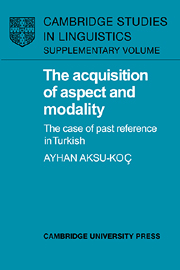Book contents
- Frontmatter
- Contents
- List of figures
- List of tables
- Acknowledgements
- Symbols and abbreviations
- PART I TENSE, ASPECT AND MODALITY IN ACQUISITION
- 1 Introduction
- 2 Tense, aspect and modality
- 3 Theoretical and empirical research on the development of temporal reference
- PART II DEVELOPMENT OF PAST REFERENCE IN TURKISH: FROM ‘PERFECT’ ASPECT TO ‘EVIDENTIAL’ MODALITY
- PART III CONCLUSIONS AND GENERAL IMPLICATIONS
- Appendix A
- Notes
- Bibliography
- Subject index
- Name index
1 - Introduction
Published online by Cambridge University Press: 23 September 2009
- Frontmatter
- Contents
- List of figures
- List of tables
- Acknowledgements
- Symbols and abbreviations
- PART I TENSE, ASPECT AND MODALITY IN ACQUISITION
- 1 Introduction
- 2 Tense, aspect and modality
- 3 Theoretical and empirical research on the development of temporal reference
- PART II DEVELOPMENT OF PAST REFERENCE IN TURKISH: FROM ‘PERFECT’ ASPECT TO ‘EVIDENTIAL’ MODALITY
- PART III CONCLUSIONS AND GENERAL IMPLICATIONS
- Appendix A
- Notes
- Bibliography
- Subject index
- Name index
Summary
A brief look at the short history of developmental psycholinguistics reveals that the last two and a half decades have witnessed major developments in the field, mostly parallel to those in linguistic theory. The initial emphasis of the 1960s on the acquisition of the structural aspects of language shifted to issues of semantics and finally to the important contributions of pragmatics in the late 1970s. Today, it is well recognized that the problem of language acquisition can be approached only from a multidimensional perspective, considering the interplay of syntactic, semantic, pragmatic and cognitive factors that simultaneously bear upon the process. Such a multidimensional approach aims to delineate the interactive contributions of the different factors to the construction of the emergent systems of the child at different stages in development.
Stimulated by Chomsky's theory of Transformational-Generative Grammar (1957, 1965), and his hypothesis of innate linguistic structures, early investigations of child language were concerned with language as a formal system and focused on the acquisition of its structural aspects. The shift of emphasis from syntactic to semantic structures for an adequate characterization of the universals of language brought about by Generative Semantics and Case Grammar (Fillmore, 1968; Jackendoff, 1972; Lakoff, 1973; Parisi and Antinucci, 1976) was immediately reflected in acquisition studies and called attention to the role of cognitive developmental factors. The most comprehensive theoretical framework accounting for the development of the structures of intelligence in the child has been Piaget's.
- Type
- Chapter
- Information
- The Acquisition of Aspect and ModalityThe Case of Past Reference in Turkish, pp. 3 - 10Publisher: Cambridge University PressPrint publication year: 1988

